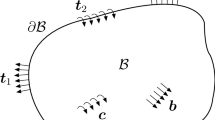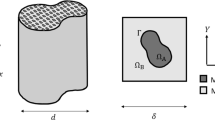Abstract
The finite element (FE) method was used to calculate the axial and radial stress distributions as a function of axial distance, z, from the centre, and radius, r, in an elastic fibre surrounded by a plastic matrix. Plastic deformation of the matrix was considered to exert a uniform interfacial stress, τ, along half the length of the fibre. Axisymmetric models were created for uniform cylindrical, ellipsoidal, paraboloidal and conical fibres characterised by an axial ratio, q, and half length, L. Young's modulus for the material of the fibre and L were arbitrarily assigned values of unity, since they act as scaling factors; q also acts as a scaling factor but was assigned a value of 10 to create models with a fibrous appearance. For the cylindrical fibre, the axial stress increased linearly from the end towards the centre; the radial stress was more evenly distributed. At the other extreme, the conical fibre showed a uniform distribution of axial and radial stress. Results for ellipsoidal and paraboloidal fibres were intermediate between these two extremes. In general, the effect of taper is to lower peak stress at the fibre centre and make the stress distribution throughout the fibre more even. These results are in good agreement with recent analytical theories for the axial distribution of surface radial stress and axial stress along the fibre axis. However, FE models have the advantage of predicting full three-dimensional stress distributions.
Similar content being viewed by others
References
H. L. Cox, Br. J. appl. Phys. 3 (1952) 72.
A. Kelly and W. R. Tyson, J. Mech. Phys. Solids 13 (1965) 329.
R. M. Aspden, Proc. R. Soc. Lond. B 258 (1994) 195.
K. L. Goh, R. M. Aspden, K. J. Mathias and D. W. L. Hukins, Proc. R. Soc. Lond. A 455 (1999) 3351.
B. D. Agarwal and L. J. Broutman, “Analysis and Performance of Fibre Composites,” (John Wiley &Sons, New York, 1980) p. 73.
D. F. Holmes, J. A. Chapman, D. J. Prockop and K. E. Kadler, Proc. Natl. Acad. Sci. 89 (1992) 9855.
J. A. Trotter, F. A. Thurmond and T. J. Koob, Cell Tissue Res. 275 (1994) 451.
J. E. Devente, G. E. Lester, J. A. Trotter and L. E. Dahners, J. Electron Microsc. 46 (1997) 353.
A. M. Niazy, BENCHmark July (1998) 6.
R. M. Aspden, J. Mater. Sci. 29 (1994) 1310.
L. N. G. Filon, Phil. Trans. R. Soc. Lond. A 198 (1902) 147.
A. S. Carrara and F. J. McGarry, J. Comp. Mat. 2 (1968) 222.
Author information
Authors and Affiliations
Rights and permissions
About this article
Cite this article
Goh, K.L., Mathias, K.J., Aspden, R.M. et al. Finite element analysis of the effect of fibre shape on stresses in an elastic fibre surrounded by a plastic matrix. Journal of Materials Science 35, 2493–2497 (2000). https://doi.org/10.1023/A:1004725903966
Issue Date:
DOI: https://doi.org/10.1023/A:1004725903966




